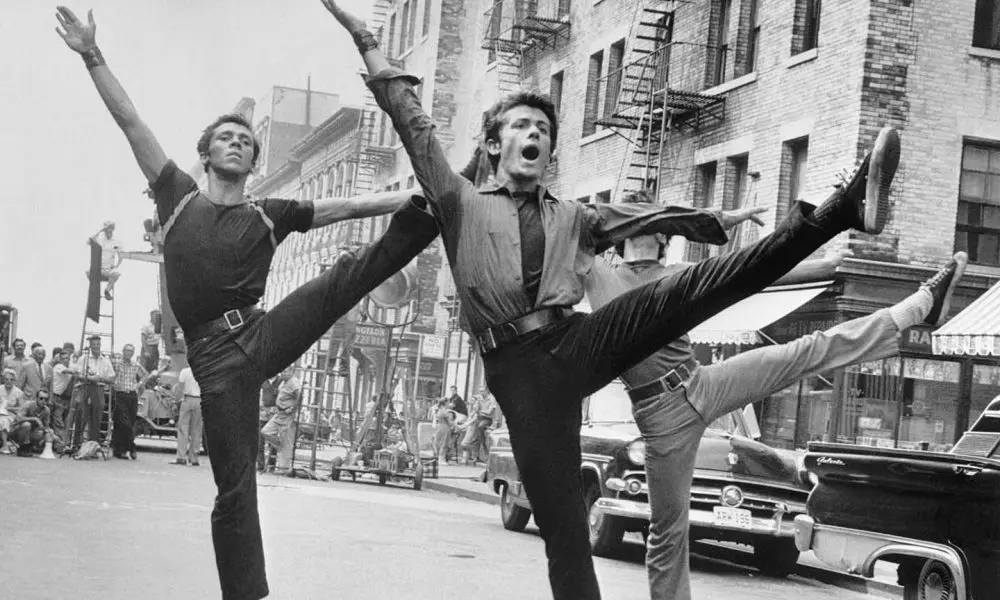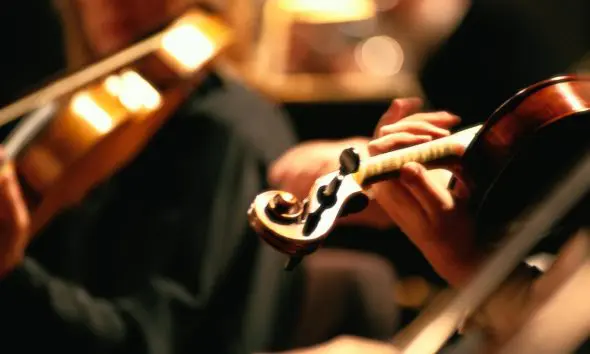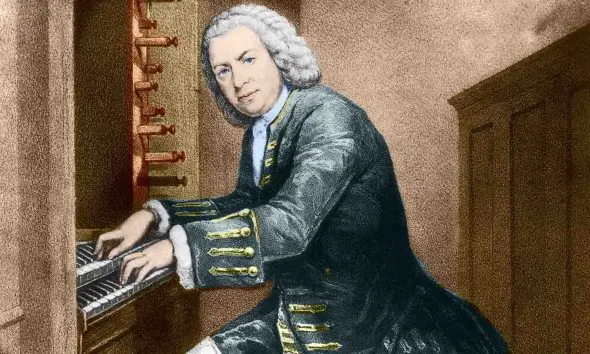‘West Side Story’: The Genesis Of A Musical
Discover the story behind one of the greatest and most successful of all stage musicals – Leonard Bernstein’s ‘West Side Story.’

West Side Story, one of the greatest and most successful of all stage musicals, tells the classic tale of fierce rivalries and young love in 1957 New York City. Steven Spielberg’s remake of West Side Story, adapted for the screen from the original 1957 Broadway musical with book by Arthur Laurents, music by Leonard Bernstein, lyrics by Stephen Sondheim and concept, direction and choreography by Jerome Robbins. will be released on 10 December 2021. The film stars Baby Driver’s Ansel Elgort as Tony and newcomer Rachel Zegler as Maria, the young lovers trapped in a feud between rival gangs the Sharks and the Jets. Watch the trailer for Steven Spielberg’s West Side Story and scroll down to discover the story behind the Broadway musical.
West Side Story: The Genesis
There can be few people who have never heard at least one of these songs at some point in their lives: ‘Maria’, ‘Tonight’, ‘America’, ‘One Hand, One Heart’, ‘I Feel Pretty’ and ‘Somewhere’. What a sequence of hits! And that’s without numbers like ‘Jet Song’, ‘The Rumble’ and ‘Gee, Officer Krupke’. “Oh yes,” you’d say, without a moment’s hesitation on hearing any of these, “That’s from West Side Story.”
Listen to Leonard Bernstein Conducts West Side Story on Apple Music and Spotify now.
Most of us know that the musical is based on a modernised version of Shakespeare’s Romeo and Juliet. But how many know that during the show’s lengthy gestation the familial protagonists of the play – the Montagues and Capulets – were initially transformed into religious protagonists: Catholics (Romeo’s side) versus Jews (Juliet’s). And did you know that this, one of the greatest and most successful of all stage musicals, was going to be called East Side Story?
In fact, the original concept dreamt up in 1949 by acclaimed Broadway and ballet choreographer Jerome Robbins, quickly fizzled out when he and his two collaborators could not agree on how to proceed with the project. It was another six years before they got together again and began work on the show.
West Side Story eventually opened on Broadway in 1957
In the end, the musical West Side Story eventually opened on Broadway on 26 September 1957 and ran for 732 performances. It was nominated for six Tony Awards. The 1961 film adaptation was nominated for 11 Academy Awards and won ten, including Best Picture.
Robbins had first collaborated with the talented young composer and conductor Leonard Bernstein in 1944 on the ballet Fancy Free. That was swiftly followed by On the Town (music by Bernstein, book and lyrics by Betty Comden and Adolph Green), a musical inspired by Fancy Free. Robbins then invited playwright Arthur Laurents (who had never written a musical libretto) to collaborate with them on his Romeo and Juliet project. Robbins, Bernstein and Laurents all had different ideas on how the subject should be approached, not least when it was realised that the Catholic-Jewish theme had already been tackled a number of times.
What brought them back together? Laurents was in Hollywood working on the screenplay of The Painted Veil, a re-working of Greta Garbo’s 1934 hit, to star Ava Gardner. Bernstein was in Los Angeles conducting at the Hollywood Bowl. The two got together and talk soon turned to the recent outbreak of racially-motivated gang warfare in several U.S. cities. Shifting the action of their shelved musical to Manhattan’s Upper West Side and making the protagonists white Americans (The Jets) and Puerto Ricans (The Sharks) made perfect, if uncomfortable, dramatic sense. Robbins also turned up in Hollywood to choreograph the film of The King and I. The three met up – Robbins loved the idea of a musical with a Latino beat – and were now of one mind.
Bernstein began to write music – as well as lyrics to his music – with extended dance sequences for Robbins, at the same time working on his comic operetta Candide. It was an overwhelming burden of work. Bernstein decided to abandon lyrics. The team called in Comden and Green again. They were not available, opting instead to write the lyrics for the musical of Peter Pan. Who to ask?
Oscar Hammerstein II persuaded Sondheim to write the lyrics
Theatre producer Martin Gabel had recently (1955) introduced Laurents to a young composer-lyricist named Stephen Sondheim who had just written his first professional musical, Saturday Night (aborted because of the death of its producer). With Comden and Green out of the picture, Laurents asked Sondheim if he would be interested in the new project. Sondheim demurred. He was determined that for his next project he would write both music and lyrics. It was his mentor, Oscar Hammerstein II, who persuaded him to collaborate, saying he would “benefit from the experience” – if only as lyricist – and give him his Broadway debut.
The team was now in place. The show’s title East Side Story was replaced by Gangway, then by Kids With Matches and changed again to Shut Up and Dance (the latter recycled for a lyric in Gypsy, the next Robbins-Sondheim musical) before finally they decided on West Side Story. Many other changes were made during its creation. For instance, Tony and Maria’s duet ‘One Hand, One Heart’ was originally intended for Candide but was switched to West Side Story and placed in the balcony scene. On the advice of Hammerstein, it was moved to the scene in the bridal shop. ‘Tonight’ was written to replace it. The music for ‘Gee, Officer Krupke’, injecting some much-needed comic relief, was also originally written for Candide.
Sondheim convinced his friend Hal Prince to produce the show
With the show nearing completion by the autumn of 1956, it was time to get a producer in place. Roger L. Stevens was a constant, but as late as Spring 1957 his co-producer Cheryl Crawford pulled out with two months to go before the start of rehearsals. Every other producer had turned it down, deeming it too dark and depressing. It was Sondheim who convinced his friend Hal Prince to take a chance. Prince and his producing partner Robert Griffith flew to New York to hear the score. “Sondheim and Bernstein sat at the piano playing through the music,” Prince recalled in his memoirs, “and soon I was singing along with them.”
At a cost of $350,000, West Side Story finally went into production. Early on, Laurents had wanted James Dean to play the lead role of Tony. That dream was not to be (Dean died in a car crash in 1955). Sondheim found the unknown Larry Kert and Chita Rivera, original cast members who defined the production in key roles.
The pre-Broadway runs in Washington D.C. and Philadelphia were critically and commercially successful, but the reviews did not mention ‘co-lyricist’ Sondheim, over-shadowed by the much better-known Bernstein. By the time the show reached Broadway, Bernstein had magnanimously dropped his ‘co-lyricist’ credit. Robbins, however, demanded and got a ‘conceived by’ credit which he used to make a number of substantial changes to the show – without consulting his co-creators. By the opening night on Broadway, none of them were speaking to him.
Sondheim is the only surviving member of the collaborators
Bernstein was to write only one other musical: a disastrous 1976 collaboration with Alan Jay Lerner called 1600 Pennsylvania Avenue. Laurents, Robbins and Sondheim, on the other hand, followed West Side Story with Gypsy. The producer was again, Hal Prince, who would now become a key figure in the development of the modern musical both as producer and director. Sondheim, now 91, is the only surviving member of the original quartet of collaborators and is now the revered elder statesman of the Broadway musical, a figure of almost legendary status. One wonders what would have happened if he had not taken up the invitation to write the lyrics of West Side Story.
Recommended Recording
In 1984, 27 years after the premiere, Leonard Bernstein conducted the complete score of West Side Story for the first time. The all-star cast for Leonard Bernstein Conducts West Side Story features Kiri Te Kanawa as Maria and José Carreras as Tony.
Leonard Bernstein Conducts West Side Story can be bought here.





Barbara Weaver
April 20, 2022 at 1:27 pm
I enjoyed the article, but may I point out that
Chita Rivera did NOT play Maria in the original
production: she was cast as Anita, & continued
in the part when the production came to London:
To watch her onstage was a magical experience,
never to be forgotten by those who witnessed
her dancing, singing, & acting!
I believe that ‘A Boy Like That’ — with its
cracking rage — was written for Rivera…